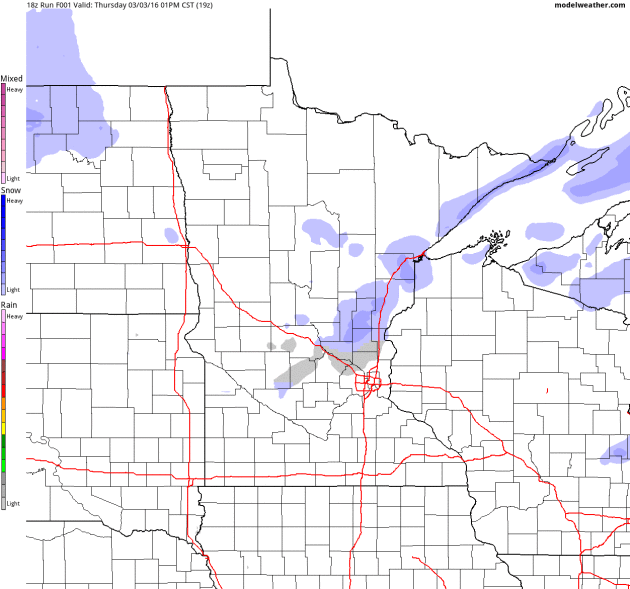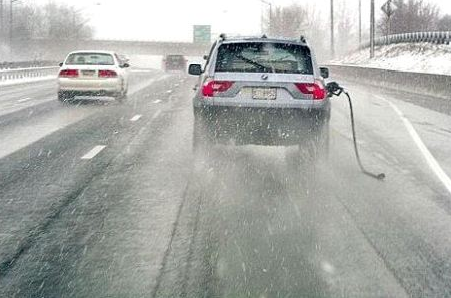35 F. average high on March 3.
29 F. high on March 3, 2015.
March 4, 1935: An extremely damaging ice storm hits Duluth. At the time it was called 'The worst ice storm in Duluth’s history'. The storm began with freezing rain and wet snow falling at the Duluth Weather Bureau at 7th Ave West and 8th Street at 10pm on March 3rd. The temperature was 26 degrees. By the morning of the 4th, the snow stopped but the freezing rain continued. The lights started going out in Duluth by 6pm on the 4th due to power lines breaking. By the morning of the 5th, Duluth was virtually isolated from the outside world except for shortwave radio. A local ham radio operator sent the Duluth National Weather Service reports: Four streetcars had to be abandoned in the storm, three of them in the western part of the city. A heavy salt mixture and pickaxes were used to try to free the stuck streetcars. A one-mile stretch of telephone poles along Thompson’s Hill was broken off as if they were toothpicks due to the ice.

Sloppy Mix Today. Preview of April Next Week
“Despite the forecast, live like it's spring” wrote Lilly Pulitzer. Actually the forecast does look like spring, a much-advertised "fast-forward" spring. Winter is gasping for (cold) air; by next Tuesday it may feel like early April with 60F and a few grumbles of thunder.
Why so mild so early? Why are tracking rain showers instead of Tournament Snowstorms? Proving cause and effect with the atmosphere is a losing proposition, a little like trying to deconstruct the ingredients in a souffle.
My take? Two main factors: warm whispers of a strong El Nino and a warm/wet MJO (Madden-Julian Oscillation) signal pushing across the Pacific; the icing on the simmering cake of a steadily warming planet. If anyone asks, February was the 6th warmer-than-average month in a row.
Today will be sloppy with with a rain/snow mix; most roads wet after 10 AM. The sun comes out Saturday, 50F Sunday afternoon - the best chance of nudging 60F Tuesday, again next Friday.
Not exactly shorts and T- shirt weather, but I think you can safely retire the parka. You know, the one covered in cobwebs?
* 4 KM NAM Precipitation Type forecast courtesy of NOAA and AerisWeather.
Map credit: Midwest Regional Climate Center.
Bottom Line...
- The threat for significant, impactful, snowmelt flooding is now very low:
-- Much less than historical risk for Red River Basin locales.
-- Near historical risk for the Devils Lake Basin..."
Map credit above: "Global
temperatures hit a new all-time record high in February, shattering the
old record set just last month amid a record-strong El Niño." Ryan Maue/Weatherbell Analytics.
Image credit above: "Daily Arctic sea ice extent comparison between average and the past five years." Credit: NSIDC
Hell and High Water. ProPublic and the Texas Tribune
have a remarkable (and visual) story focused on how Houston dodged a
bullet with Ike; at some point the law of averages will catch up and a
devastating hurricane will push into Galveston and Houston. Is the city
ready? Here's an excerpt: "They called Ike “the monster
hurricane.” Hundreds of miles wide. Winds at more than 100 mph. And —
deadliest of all — the power to push a massive wall of water into the
upper Texas coast, killing thousands and shutting down a major
international port and industrial hub. That was what scientists, public
officials, economists and weather forecasters thought they were dealing
with on Sept. 11, 2008, as Hurricane Ike barreled toward Houston, the
fourth-largest city in the United States and home to its largest
refining and petrochemical complex. And so at 8:19 p.m., the National
Weather Service issued an unusually dire warning.
“ALL
NEIGHBORHOODS, AND POSSIBLY ENTIRE COASTAL COMMUNITIES, WILL BE
INUNDATED,” the alert read. “PERSONS NOT HEEDING EVACUATION ORDERS IN
SINGLE FAMILY ONE OR TWO STORY HOMES WILL FACE CERTAIN DEATH.”
.jpg)
Extreme Tornado Outbreaks Have Become More Common. New research highlighted at The International Research Institute for Climate Policy at Columbia University's Earth Institute made me do a double-take; here's the intro: "Most death and destruction inflicted by tornadoes in North America occurs during outbreaks—large-scale weather events that can last one to three days and span huge regions. The largest outbreak ever recorded happened in 2011. It spawned 363 tornadoes across the United States and Canada, killing more than 350 people and causing $11 billion in damage. Now, a new study shows that the average number of tornadoes in these outbreaks has risen since 1954, and that the chance of extreme outbreaks —tornado factories like the one in 2011—has also increased. The study’s authors said they do not know what is driving the changes. “The science is still open,” said lead author Michael Tippett, a climate and weather researcher at Columbia University’s School of Applied Science and Engineering and Columbia’s Data Science Institute..." (The paper below is available at Nature Communications).
Photo credit above: Meteorologist Aaron Shaffer, minnyapple.com.
What Does a Warming Arctic Have to do with snow in New England? Plenty. Here's an excerpt of a fascinating story at Alaska Dispatch: "Isotopes in water molecules act like a “chemical fingerprint,” said Jeff Welker, a UAA biology professor involved in the project. Analysis by Welker, UAA postdoctoral fellow Eric Klein and their research partners at the State University of New York and other institutions parsed out the isotopes associated with the Arctic -- considered a cold, dry source of water -- and matched them to the heavy precipitation events at the New Hampshire location. The analysis also tracked increasing incidences of Arctic-marked rain and snowfall over time with reduced Arctic sea ice -- and with polar vortex events like the one that warmed Alaska but chilled the U.S. East Coast in the winter of 2013-14. The chemical evidence backs up the emerging theory that the rapid warming of the Arctic is slowing the jet stream, causing a wavy pattern that brings warm weather to the far north and cold weather to the middle latitudes, Welker and Klein said..."
Photo credit above: "In this Feb. 23, 2015 file photo, a car remains buried in snow along a residential street in South Boston. Boston's 2015 winter was also its snowiest season going back to 1872. Now, researchers have determined that all that snow in the Northeast U.S. may be due in part to warming in the Arctic." Elise Amendola / Associated Press file photo
Why Are So Many People Still Living in Flood-Prone Cities? Easy transportation and trade is one answer, but that comes with a downside as seas continue to rise. Here's a clip from The Conversation: "Over the last 30 years, floods have killed more than 500,000 people globally, and displaced about 650m more. In a recent paper
published by the Centre for Economic Performance, we examined why so
many people are hit by devastating floods. We looked at 53 large floods,
which affected more than 1,800 cities in 40 countries, from 2003 to
2008. Each of these floods displaced at least 100,000 people from their
homes. Of course, part of the problem is that many cities were
originally built near rivers and coastlines. For a long time, these
cities’ residents benefited from lower transport costs, because they were close to ports and the trade which occurred there..."
Photo credit above: johnmcq/Flickr, CC BY-NC
Image credit: "For January 2012, brown shades show the decrease in water storage from the 2002-2015 average in the Mediterranean region. Units in centimeters. The data is from the Gravity Recovery and Climate Experiment, or GRACE, satellites, a joint mission of NASA and the German space agency."
Credit: NASA/ Goddard Scientific Visualization Studio. Details at the American Geophysical Union.
Photo credit: "A Syrian refugee camp in Turkey." Credit: European Parliament.
A Plan In Case Robots Take the Jobs: Give Everyone a Paycheck.
Why is there so much unsease and anger out there? Globalization,
automation, computerization, jobs being done by robotics that were done
by hand 10 years ago. The cycle of disruption is happening faster.
Suddenly there's no such thing as a "job for life". Here's a clip from The New York Times: "Let’s
say computers come for most of our jobs. This may not seem likely at
the moment; computer scientists and economists offer wildly varying
ideas for how deeply automation will affect future employment.
But for the sake of argument, imagine that within two or three decades
we’ll have morphed into the Robotic States of America. In Robot America,
most manual laborers will have been replaced by herculean bots.
Truck drivers, cabbies, delivery workers and airline pilots will have
been superseded by vehicles that do it all. Doctors, lawyers, business
executives and even technology columnists for The New York Times will
have seen their ranks thinned by charming, attractive, all-knowing
algorithms..."
Listen Up Candidates: Science Matters, and Here's Why. Scientific American has a link to a good explainer video: "Because researchers work on solving problems that every politician should care about—including climate risks, clean energy, new materials, emerging diseases and a wide range of technologies that can fuel economic growth—the Science Coalition, a group of universities that lobbies for federal investments in research, is sponsoring an event called Super Science Tuesday. It's a video compilation in which scientists tell the candidates why they need to pay attention..."
Image credit: National Human Genome Research Institute, National Institutes of Health.
Almost 100 Million Homes May Run Only on Solar by 2020. Bloomberg Business has the story - here's a link and excerpt: "Almost 100 million households worldwide may be powered by solar panels by 2020, according to Bloomberg New Energy Finance. The off-grid solar market has grown to $700 million now from non-existent less than a decade ago, according to a report Thursday from the London-based research company and the World Bank Group’s Lighting Global. They expect that to swell to $3.1 billion by the end of the decade..."
Photo credit above: "Workers secure solar panels to a rooftop in Albuquerque, New Mexico." Photographer: Sergio Flores/Bloomberg.
Future of U.S. Solar Threatened in Nationwide Fight Over Incentives. Reuters has an update; here's an excerpt: "Two sun-drenched U.S. states have lately come to very different conclusions on a controversial solar power incentive essential to the industry's growth. In California, regulators voted in January to preserve so-called net metering, which requires utilities to purchase surplus power generated by customers with rooftop solar panels. But neighboring Nevada scrapped the policy - prompting solar companies to flee the state. The decisions foreshadow an intensifying national debate over public support that the rooftop solar industry says it can't live without..."
Photo credit above: "Solar panels are pictured on the rooftops of residential homes in San Diego, California in this August 21, 2015 handout photo." Reuters/Mike Blake.
Photo credit above: "As part of a wider effort to reduce waste and energy consumption, Hamburg, Germany, has become the world's first city to ban the use of coffee pods in government-run buildings, offices and institutions like schools and universities." sg_harrison/Flickr
“There are definitely areas where the earth is covered with pollution almost all the time. And it’s not good for any of us. There are weather systems that I’ve seen while I was up here that were places that were unexpected. Storms bigger than we’ve seen in the past. And this is a human effect. You can tell that that is not a naturally occurring phenomenon.”Image credit above: Scott Kelly @StationCDRKelly /Victoria Fleischer /ThinkProgress.

TODAY: Rain/snow mix. Wet/slushy roads. Winds: S 10-20. High: 38
FRIDAY NIGHT: Light rain tapers. Low: 30
SATURDAY: Blue sky, light winds. Very nice. Winds: NW 5-10. High: 41
SUNDAY: Partly sunny, windy & milder. Winds: S 10-20. Wake-up: 29. High: 51
MONDAY: Clouds increase, late rain shower. Winds: S 10-20. Wake-up: 41. High: 54
TUESDAY: Mild and unsettled, risk of a T-shower. Winds: W 10-20. Wake-up: 48. High: near 60
WEDNESDAY: Sunny spurts, turning cooler. Winds: NW 7-12. Wake-up: 33. High: 47
THURSDAY: Mostly cloudy, trending milder again. Winds: S 10-15. Wake-up: 34. High: 54
Climate Stories....
Climate Scientists Worry About the Costs of Sea Level Rise. Here's an excerpt of a post at The Guardian from University of St. Thomas climate scientist John Abraham: "...A paper was just published by Drs. Boettle, Rybski and Kropp that dealt with this question. The authors of this study note that if you are concerned about societal and economic costs, the rate of sea rise isn’t the entire story. Much of the damage is caused by extreme events that are superimposed on a rising ocean. Damage is highly nonlinear with sea rise. To explain this, let’s think about flooding. Consider a river that has a dike system capable of confining a rise of water up to six feet. Such a system would have little or no economic/societal damage for “floods” up to six feet, but just one more foot of water rise would put the waters over the dike and could cause significant losses..."
Photo credit above: "The remnants of the Jet Star roller coaster is pictured in the ocean, almost five months after Superstorm Sandy, in Seaside Heights, New Jersey March 21, 2013." Photograph: Lucas Jackson/REUTERS.

More details and a link to the new research at The Lancet. Photo credit: Tim McCabe, USDA.
Pending Prosecution of Fossil Fuel Companies Over Climate Denial? Here's an excerpt from Bloomberg BNA: "...I'm confident the U.S. Department of Justice will also do an investigation, and they in fact may be doing one now. In my experience, they typically don't say they're doing investigations. Same with the Securities and Exchange Commission—they may not say they're doing an investigation. If you look at what the fossil fuel companies—and I specifically say companies because now there's evidence that it wasn't just Exxon Mobil who knew about climate change—planned for it and then denied it. Shell also knew about climate change, planned for it and then publicly denied it. That set back the fight against climate change for decades, which is unfortunate because [the necessary action] is not just merely taking carbon, methane and other greenhouse gases out of the air. It's taking it out of the air within a certain amount of time..." (File image: LM Otero, AP).
Justice Department Refers Exxon Investigation Request to FBI. InsideClimate News has more details: "The
U.S. Justice Department has forwarded a request from two congressmen
seeking a federal probe of ExxonMobil to the FBI's criminal division. U.S. Representatives Ted Lieu and Mark
DeSaulnier sought the probe last year to determine whether the oil
giant violated federal laws by "failing to disclose truthful
information" about climate change.
In response, the Justice Department deferred to the FBI, saying it is
that agency's responsibility to conduct an initial assessment of facts
that prompted the congressmen's request. Such action is considered
standard procedure, according to former federal prosecutors who say the
response appears ambiguous as to what action may be taken by the FBI..."
Photo credit: "California
Rep. Ted Lieu, along with fellow Democrat Rep. Mark DeSaulnier, issued
the request that the Justice Department investigate Exxon for its
climate research and denial."
Graphic credit: Yale Program on Climate Change Communication Get the data. Created with Datawrapper.
No comments:
Post a Comment